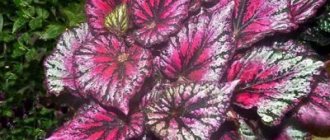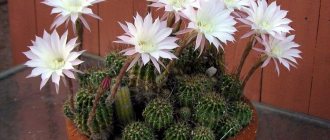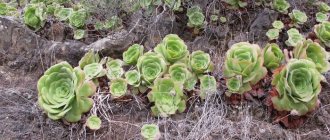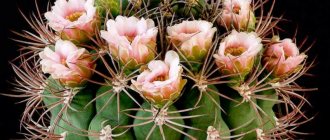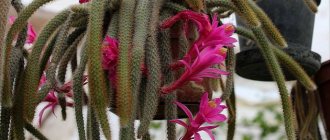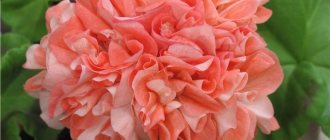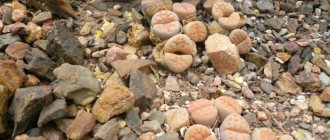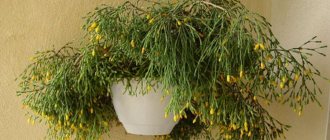Unusual, sometimes a little strange and at the same time royally magnificent representatives of the Cactus family appeared in Europe in the first year of the 18th century.
The special appearance and unpretentiousness of the envoys of South America attracted the attention of flower growers and contributed to their widespread distribution - various types of cacti could be found in greenhouses and botanical gardens of many European cities.
And soon they took the best places in private collections of tropical plant lovers and on the windowsills of ordinary houses.
Features of the genus
Translated from Greek, its name means hedgehog .
At the beginning of development, these cacti really look like prickly hedgehogs curled up into a ball. Echinopsis have fleshy stems and a powerful root system. The roots are located close to the surface. Their flowers are very large, located on a long, pubescent stalk. Some have a pleasant aroma.
Different species bloom from early spring to late autumn. Each flower lives in bloom for only a day or two.
The number of flowers on a plant reaches 20-25 pieces . They produce a red or yellowish fruit in the shape of a ribbed barrel or ball.
They grow very quickly, the first flowers appear at the age of 3 years . Varietal varieties grow more slowly.
Echinopsis flowering
Pereskia spinosa: examples of plant care at home
Echinopsis is a flowering cactus, but not everyone who has ever decided to have this “spiny hedgehog” on their windowsill has had the honor of contemplating a short, but very spectacular flowering.
How to make a cactus bloom
Compliance with the described standards is guaranteed to help you see the rare flowering of any type of echinopsis. The plant blooms in its natural environment in the spring, almost immediately after waking up from sleep. Even modified cristates bloom, which are considered abnormally modified plants with a falsely directed growth point.
Flowering crest
The main secret thanks to which the cactus will bloom is proper wintering. For a plant to bloom, it must understand that spring has come, that is, overwinter and feel the warming. For the winter, the pot with echinopsis should be placed in unheated but insulated rooms with sufficient sunlight. The temperature in winter should be close to +5˚C and not fall below this mark. With the onset of warmth, the plant itself will wake up, certainly delighting its caring owners with bright and large flowers.
Caring for cacti is not difficult; they are one of the most unpretentious plants. When they open their buds, they can safely be called the kings of contrasts and paradoxes. It is impossible to believe your eyes when, in just one night, a bright flower of incomparable size suddenly appears from a prickly and boring hedgehog.
Kinds:
- Eyrieza Dark green Echinopsis, spherical in young specimens and short-cylindrical in adult specimens.
Height 20-22 cm, diameter about 15 cm.Areoles are white-yellow, round. The spines are long. The flowers are elongated, white-pink.
- Chilean Tree-like, branches at the base. The stem is cylindrical, elongated. Ribs with pronounced tubercles, low. Pale yellow, one to two centimeters long. The central spine is 4-7 cm . The flowers are large, about 14 centimeters in length.
- Pampana The stem is spherical, 5-7 centimeters in diameter. The spines are curved, up to 5 centimeters long . The flowers are red.
- Shilya
The height of the stem is 5-6 centimeters. About 14 ribs .
The areoles and spines are white. The flowers are fiery red and erect. - Klinger Stem spherical at the top, cylindrical at the base.
The spines are long, grayish, located on light, pubescent areoles. Flowers with multi-tiered petals, snow-white with dark tips. - Dumat The stem is low-growing, rounded, with pronounced ribs. The spines are small. The flowers are lilac-white.
- Sharp-edged , spherical, somewhat elongated stem, diameter 20-25 cm , length 15 cm. Covered with pointed ribs with large areoles. The flowers are lilac-red. Blooms at night, in May-June.
- Mammillosa kermesina Exquisite form of the Echinopsis cactus, single stem, about 30 centimeters . The areoles are round with yellow awl-shaped spines. Pink flowers grow in tiers.
- Tubeflower Green, initially spherical, then cylindrical-shaped stem. The spines are brown, black at the tips. It blooms with large, funnel-shaped, white flowers on a twenty-centimeter stalk.
- Ancistropha Green small stem in the shape of a flattened ball. Covered with pronounced tubercles and hook-shaped spines. The flowers are white.
- Subdenudata
It differs from other species in the absence of spines. A spherical, flattened stem 20 cm high and 10 cm in diameter .
Flowers are 10 cm. Blooms at a young age. - Golden Stem is spherical at the beginning of growth and cylindrical in adults.
Pronounced ribs covered with centimeter-long spines. The flower is yellow-orange. Withstands light frosts. - Backeberg Round-cylindrical stems, height up to 7 centimeters. The flowers are bright pink.
- Bridges Grows in groups of 4 to 6 trunks. Tall, about 40 centimeters , stems with a diameter of 10-13 centimeters. The flowers are white.
- Chamecerus Forms numerous stems hanging over the edge of the pot. Blooms in spring with bright orange flowers. Frost-resistant.
- Bright green Echinopsis Globular stem with a diameter of about 9 centimeters . Sparse radial, numerous central spines.
- Coquimban Cylindrical, elongated stem. In nature it grows up to one meter. Forms dense thickets.
Description of the plant
Size and type of plant
Echinopsis chamaecereus is a turf-forming cactus with numerous finger-like shoots and scarlet flowers that can reach a height of 15 cm.
IN THE PHOTO: Echinopsis chamecereus. Author of the photo: @kari_ve.
Stem
Young shoots of this Echinopsis resemble peanuts, but over time they lengthen, become cylindrical and finger-shaped. They are very soft and pale green in color.
IN THE PHOTO: The main stems of Echinopsis chamecereus, about 15 cm long, 2 cm in diameter, as a rule, lie on the surface of the soil; numerous side shoots of much smaller size grow from them. Photo by: @coastalcacti.
Ribs
The stem is divided into 8–10 narrow, low ribs with wide depressions between them.
Areoles, spines
The areoles are small, located along the ribs close to each other.
IN THE PHOTO: Each areola on the stem of this cactus bears from 10 to 15 short whitish spines. Photo by: @the.plant.lass.
Flowers
The flowers are dark scarlet, cup-shaped, about 2.5 cm in diameter. Each flower lasts for about one day, but the flowering period lasts from two to three weeks.
IN THE PHOTO: Under favorable conditions, Echinopsis chamecereus blooms profusely from early spring to summer. Photo by: @mrcoverings.
Varieties
Echinopsis chamaecereus 'lutea' is a variety with yellow shoots. This plant does not contain chlorophyll, so it cannot grow on its own roots and must be grafted onto another cactus, for example, one of the Cereus. In all other respects, including scarlet flowers, which look especially attractive against the background of yellow stems, this variety is no different from the usual Echinopsis chamecereus.
IN THE PHOTO: Echinopsis chamaecereus 'lutea' does not propagate by cuttings; it can be purchased already grafted.
The delicate body of this cactus in summer needs protection from direct sunlight, which can cause burns. The minimum temperature that this variety can withstand depends on the rootstock, on average it is +10°C.
Photo
Below are photos of a cactus of the Echinopsis species
Development of Echinopsis cactus hybrids
The numerous species of Echinopsis cover a wide range of flower shades and sizes, and many species hybridize easily. Hybridization of Echinopsis became popular in the 1950s and 1960s with the first Johnson Cactus Gardens hybrids. Development continues today, primarily at the Huntington Succulent Garden International Office. Hybrids are larger plants with larger flowers that are suitable for planting outdoors. They are also well adapted to desert climates. Hybridization of Echinopsis preserves their size and maladaptation and adds even more floral shapes and colors to the palette. Bob and Bev White, founders of B&B Cactus Farm in Tucson, and Mark Dimmitt created several hybrids in the 1980s and 1990s, using the species and a few early hybrids of unknown origin. In Germany there is another center of Echinopsis hybridization.
Home care
Echinopsis can be freely purchased in the store. When purchasing, inspect it; there should be no signs of rot or pest damage.
After purchase, they are transplanted into a pot, the diameter of which is 1 centimeter larger than the store-bought one . The soil for planting is ready for succulents .
Lighting and temperature
Echinopsis love light, choose the brightest place in the apartment for them. They thrive in direct sunlight. But they need to be accustomed to this gradually to avoid burns.
Growing temperature is from 22 to 27 degrees . In summer, it is advisable to take it out onto the balcony, because there it is possible to reduce the night temperature. The difference between day and night temperatures is favorable for development.
During the autumn cooling, the temperature is gradually increased to 10-12 degrees. Some echinopsis are frost-resistant and can tolerate temperatures down to sub-zero levels.
Humidity and watering
This species tolerates dry air and low humidity.
Watering in summer is plentiful. In autumn, the amount of moisture is gradually reduced, and in November it is stopped. Resume only after a period of rest. In winter they are kept in a cold room; the moisture reserve in the powerful stem lasts until spring.
The frequency of watering and the amount of liquid depends on age. Young small specimens are watered often, adults much less often.
But in any case, the golden rule applies: it is better not to drink too much than to drink too much .
Soil and transplantation rules
This species requires a substrate with a high content of gravel and sand. You can use a store-bought one designed for succulents. You can add humus.
Transplantation is carried out at the end of winter (February) . But not often. Usually this is done through the season, from dry soil to dry soil, and do not water after the procedure for 7-10 days .
There must be drainage in the container. The container for transplantation is taken slightly larger than the previous one.
IMPORTANT . Do not plant echinopsis in a container that is too large and deep - it will not bloom. The pot should be such that there is little space for roots to grow and at the same time cramped.
Top dressing
Echinopsis are fertilized monthly during the growth and flowering period. Use special cactus fertilizer. Make sure that there is no excess nitrogen in the fertilizing, as this can cause the roots to rot.
IMPORTANT . Do not overfeed Echinopsis. It will begin to produce excessive production of children, and there will be no energy left for flowering.
Trimming
Actually, the process of removing babies cannot be called pruning. Excess shoots are simply removed from Echinopsis.
If you allow excessive shoots to form, it will not bloom.
Real pruning is carried out with an elongated corked base. In January, long before the growing season, you need to cut off the brown narrowed part of the stem with a sharp knife and sharpen it slightly.
We place the cut stem on the edge of the pot to dry. We keep it for about seven days, then place it in a bowl of water so that the cut does not reach the surface of the liquid a little.
To do this, use a cardboard stand with a hole in the middle the size of the base of the stem. After a while the roots will appear.
As soon as this happens, we plant the workpiece in the prepared slightly moist soil substrate. Do not rush to water immediately; this can only be done when the sprout takes root.
Maintenance in winter
In winter, cacti have a dormant period. At this time, you need to keep them at a temperature no higher than 10 degrees .
It is a mistake to install Echinopsis in a dark place for the winter.
With a lack of light, it will stretch out and lose its normal shape. If there are no conditions for cold wintering, place it on the windowsill and separate it from the heat with a protective screen.
One way to ensure low temperatures is to use a square aquarium. It is placed on its side, a pot is placed in it and the open side is moved towards the window. This way, your Echinopsis is in the cold, and at the same time has access to light.
During the dormant period, an adult plant is not watered; young, small specimens can be moistened, but no more than twice during the entire period.
Your pet will tell you when to resume watering by the greening of the top of its head.
Reproduction
The easiest way is reproduction by children . They are abundantly overgrown with adult specimens.
The children are separated by unscrewing and placed, slightly buried in the soil.
They take root quickly. Before planting, they are dried for 6-7 days. It is recommended to plant in a mixture of leaf soil and sand. You can add peat to it to improve aeration properties.
The seed method is a chance to get a specimen with brighter colors than the mother one.
The seeds are pre-soaked in warm water. For sowing, take a flat, shallow dish. The first layer is drainage, then a layer of soil. The surface is lightly pressed down, but not too much, to prevent stagnation of moisture.
Distribute the seeds over the surface and sprinkle them with sand. Then moisten with a spray bottle. The crops are covered with glass or film and placed in a damp, dark place until germination. The dishes are regularly aired, but not allowed to dry out.
When seedlings appear, place them in a bright, warm place and grow them as usual. It is advisable to pick when the seedlings reach the size of a large pea.
How to make Echinopsis bloom
Lack of flowering in cacti is not so rare. And the problem is primarily due to non-compliance with the temperature regime. Cacti must receive optimal temperatures in the summer months and a cool dormant period in winter - and flowering will definitely take place.
The cactus may not bloom if there is low light, frequent watering and root rot - in any case, the cause of the problem should be diagnosed and eliminated.
Diseases and pests
Echinopsis is almost not susceptible . The main problem is rotting of the roots or base of the stem due to improper watering.
Sometimes inexperienced cactus growers mistake the brown base of the stem for a disease. Don't be afraid.
This is not a disease, but an age-related suberization that is natural for an adult plant. If you don't like this look, you can bury the brown part.
The main pests of Echinopsis are scale insects and spider mites .
The presence of spider mites can be seen by the white coating on the stem. Scale insects appear in the form of brown spots. Washing with soapy water and spraying with fungicides helps combat them.
Mealybugs can also harm Echinopsis. These whitish insects settle on the stems and suck the juices from them. It is removed mechanically with a brush dipped in an alcohol solution. Then they are treated with poison.
Scale insects can also settle in the root system . The plant withers away, does not form shoots and does not bloom .
If you notice this, remove it from the pot. Shake off the soil and wash the roots in a solution of potassium permanganate. Plant in a new pot. Treat the stem with insecticides.
Reproduction methods
There are two ways to propagate echinopsis at home: seeds and offspring.
Growing from seeds
Just before sowing, soak the seeds in warm water to swell them. Take a small container and fill it with a moistened soil mixture consisting of charcoal, leaf soil and river sand (1:1:1). Add the seeds and cover with film or glass. Place the seeds in a well-lit place with a temperature of 19-20 degrees. The seeds must be regularly ventilated every day, and the substrate must be moistened at the right time. If necessary, remove condensation from the lid. As soon as the first shoots appear, remove the lid from the container. When the seedlings grow and become stronger, transplant them into separate, not too large cups.
Reproduction by children
This cactus is also easily propagated by offspring that grow directly on the parent bush. It happens that many descendants grow from one adult echinopsis. After separating the offspring, leave them outside for a while to dry. Only after this can the plant be transplanted into a separate pot. However, please note that bushes propagated in this way will bloom less frequently.
Rejuvenating an old bush
If the cactus is already very old, it is worth rejuvenating it - this procedure should be combined with vegetative propagation. It is necessary to very carefully cut off the top part of the bush and leave it outside for about half a month to dry. Only after this can it be planted in wet sand for rooting. The part of the bush that remains in the pot after pruning will also continue to grow, and many young shoots will appear.
